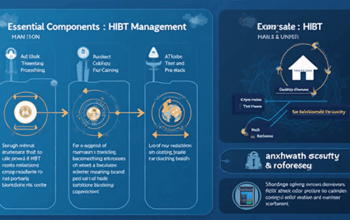Introduction
As we navigate the evolving landscape of cryptocurrency, a pressing concern has emerged: the environmental impact of digital currencies. Recent reports indicate that the carbon footprint associated with Bitcoin mining has reached alarming levels, with an estimated 0.5% of the world’s electricity consumption attributed to this process. With the global economy increasingly focused on sustainability, the quest for carbon neutrality has become paramount. It’s essential to ask: Can Bitcoin blockchain contribute to carbon neutrality?
This article delves into the intersection of Bitcoin, blockchain technology, and carbon neutrality. We will explore how advancements in blockchain can promote sustainable practices, shift the paradigm of cryptocurrency use, and align the interests of investors and environmentalists alike.
Understanding Bitcoin and Its Environmental Impact
Bitcoin operates on a decentralized, public ledger known as the blockchain, which allows multiple participants to verify transactions securely. However, the process of validating transactions—commonly referred to as mining—requires substantial computational power, leading to increased electricity consumption and significant CO2 emissions.

In 2024 alone, it was reported that over $4.1 billion was lost to DeFi hacks, highlighting not just the security vulnerabilities but also the unsustainable practices of the industry. As we often hear: “Like a bank vault for digital assets, miners need energy to ensure the security of transactions.” Yet how can we mitigate the environmental costs while maintaining the essential decentralized nature of blockchain?
Adopting Renewable Energy in Bitcoin Mining
One promising avenue for reducing Bitcoin’s carbon footprint is the transition towards renewable energy sources. A study by the Cambridge Centre for Alternative Finance found that approximately 39% of Bitcoin miners rely on renewable energy. This shift is significant, especially in regions rich in hydropower, solar, and wind resources.
- Hydropower and Bitcoin mining have already shown successes, particularly in areas like Sichuan, China, where electricity is abundant and cheap.
- Solar energy adoption in deserts and rural areas is gaining traction, providing a sustainable alternative for miners.
By utilizing renewable energy sources, miners can significantly reduce their carbon emissions while also lowering operational costs. This synergy can pave the way for a more sustainable future for the Bitcoin blockchain.
Blockchain Innovations for Environmental Monitoring
Beyond mining practices, blockchain technology itself can be leveraged to promote carbon neutrality in various sectors. Here’s how:
- Supply Chain Transparency: Blockchain can provide end-to-end visibility in supply chains, enabling businesses to track the carbon footprint of their products. This transparency fosters accountability and encourages sustainability.
- Carbon Credits Trading: Implementing a blockchain-based system for trading carbon credits can streamline transactions and reduce fraud, promoting environmental responsibility among companies.
- Renewable Energy Certificates: Blockchain can support the issuance and verification of renewable energy certificates, ensuring that energy consumers are genuinely using clean energy.
By embracing these innovations, the Bitcoin blockchain can emerge as a leader in supporting efforts towards carbon neutrality.
The Role of Regulatory Frameworks
As the cryptocurrency industry grows, the need for regulatory frameworks becomes increasingly vital. Countries like Vietnam are seeing a surge in crypto activity, with a reported 30% annual growth rate in users. With this growth, it’s essential to establish guidelines that encourage environmentally friendly practices while still fostering innovation.
Regulations targeting sustainable mining practices can incentivize investors and miners to adopt renewable technologies. Additionally, compliance with these frameworks can enhance the sector’s integrity and attract mainstream adoption.
Adopting a Global Standard: The Caso de Tiêu Chuẩn An Ninh Blockchain
In light of rising concerns, various global initiatives are being proposed, including tiêu chuẩn an ninh blockchain (blockchain security standards) that prioritize sustainability. These standards could provide guidelines for players in the cryptocurrency market, helping to gauge the environmental impact of blockchain activities.
Future Prospects: Carbon Neutrality in Bitcoin Blockchain
As we look towards 2025, the potential for Bitcoin and its blockchain technology to achieve carbon neutrality is promising yet challenging. Several factors will dictate this trajectory:
- Technological Advances: Continuous improvements in mining hardware efficiency and software can lead to lower energy costs.
- Consumer Awareness: As more individuals prioritize eco-friendly practices, their demand for sustainable cryptocurrencies will increase.
- Investment in Green Projects: Allocating funds towards renewable energy and developing blockchain solutions that enhance environmental sustainability will drive progress.
If the industry can rally around these factors and unify efforts, Bitcoin’s blockchain could lead the charge towards carbon neutrality, transforming the cryptocurrency landscape.
Conclusion
The conversation surrounding Bitcoin blockchain and carbon neutrality is no longer just aspirational; it’s imperative. With collaborative efforts from miners, regulators, and innovators, the path towards a more sustainable future is becoming increasingly clear.
As we navigate this journey, platforms like btctokenio can support these initiatives by promoting responsible practices and showcasing the benefits of sustainable cryptocurrencies. Working together, we can redefine what it means to invest in Bitcoin while safeguarding our planet.
Author: Alex Thompson, an environmental blockchain consultant with over 15 publications in blockchain sustainability and a lead auditor for the Green Mining Initiative.





